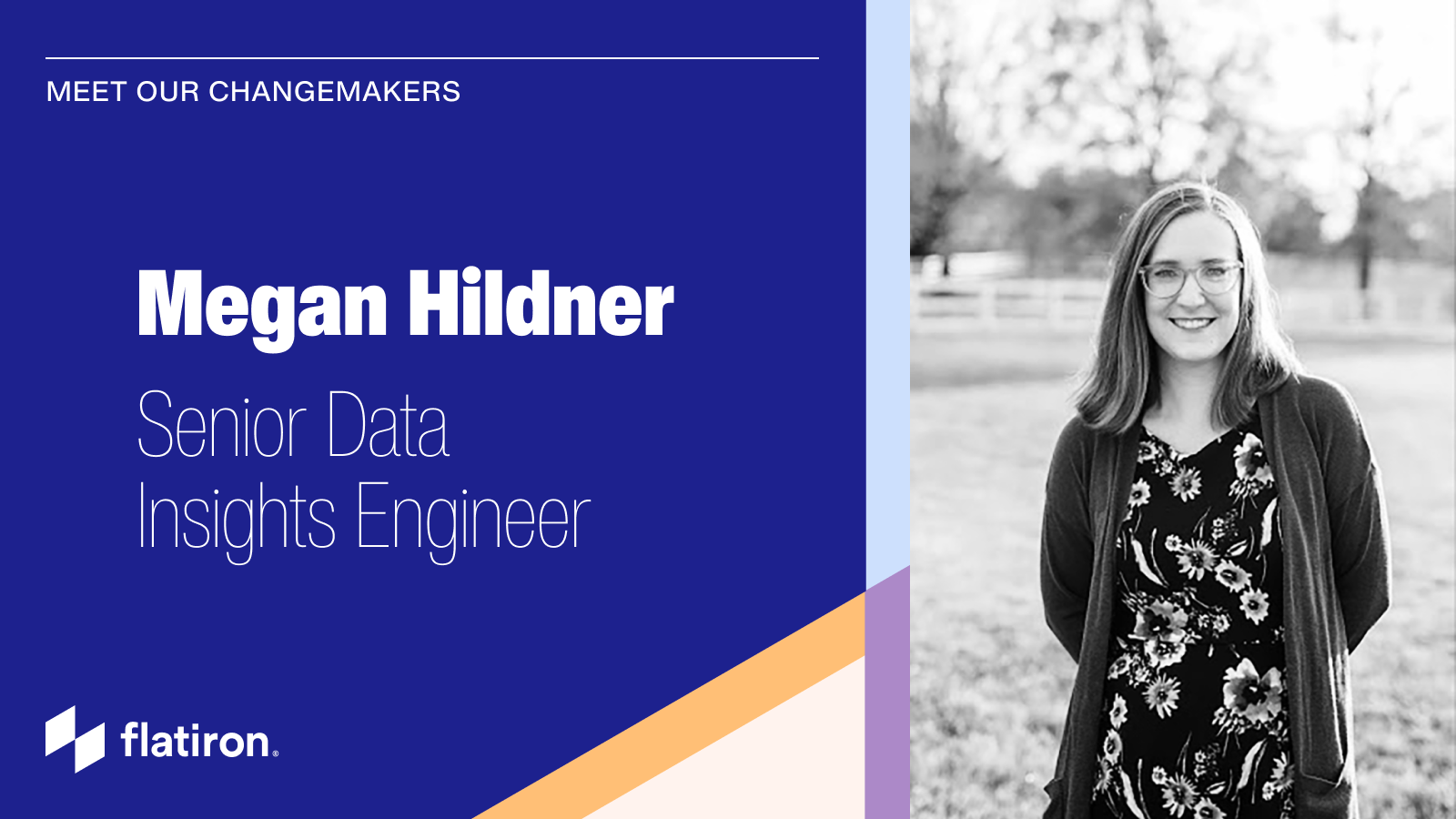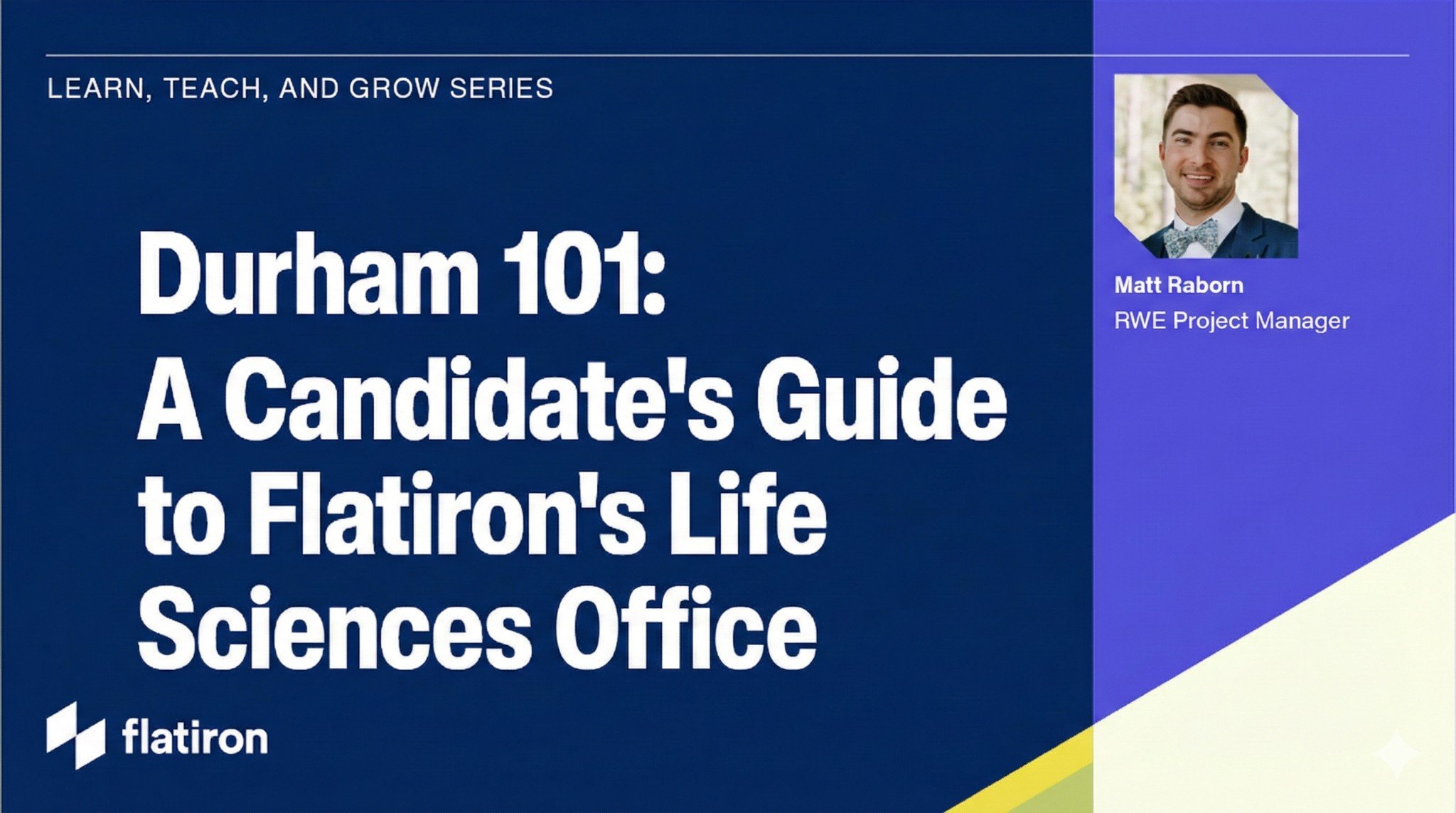At Flatiron Health, we believe that every employee has the power to make a difference. That’s why we are proud to shine a spotlight on our changemakers, the individuals who are driving meaningful impact across our organization and beyond. From engineering to clinical operations to data science and beyond, our changemakers are innovating, collaborating, and pushing boundaries to improve and extend the lives of people with cancer. In this series, we will introduce you to some of the remarkable individuals who make Flatiron Health a great place to work and a force for good in healthcare.
Meet Megan Wellons Hildner, Senior Data Insights Engineer at Flatiron Health. In this article, Megan shares her experiences, motivations, and day-to-day work. She also discusses how her work in Data Science is making a significant impact on cancer research and care in the United States.
Q: Can you tell us a little about your background and journey to Flatiron?
I studied operations research (a branch of applied math), where I found a love for modeling real-life systems with mathematics in order to figure out how to improve them. I started my career in data science for retail and e-commerce where I gained valuable experience in building effective machine learning (ML) systems for production environments. However, I felt like something was missing because, while my models were successful, their impact was limited to increasing sales. I wanted to apply my technical and product skills to an industry where my work could positively impact people’s lives, leading me to healthcare. My first foray into healthcare involved working on ML models to improve the prior authorization process at a large insurer. It was a great experience, but I missed the culture of a mid-size tech company and wanted an even stronger mission. Flatiron perfectly fit the bill, offering the tech company culture I loved from e-commerce along with the strong mission I was looking for.
Q: What is your current location, and what has been your experience working with your teammates in a hybrid work environment?
I live in Albuquerque, New Mexico, and have split my time between here and Chicago while working for Flatiron. I’ve always been a fully remote employee. The remote culture here is really great because Flatiron has invested significantly in the remote part of the hybrid experience. While it varies from team to team, the teams I’ve worked with have consisted of about one-third remote employees, and those in NYC tend to go into the office 2-3 days per week so our culture is pretty hybrid-friendly. I always feel completely looped into conversations and have a great connection with my teammates through Zoom meetings and occasional trips to NYC to meet up and collaborate with everyone in person.
Q: Provide an overview of the structure and dynamics of the machine learning (ML) team at Flatiron. How does collaboration play a role within the team itself?
We have two scrum teams of data scientists dedicated to using ML to aid in the process of turning unstructured Electronic Health Record (EHR) data into structured research data, either through direct ML extraction or by using ML to assist the human abstraction process. Additionally, there is a scrum team of software engineers that we work closely with, focusing on ML architecture, including model serving, scoring, monitoring as well as our environments and tooling. The data scientists and our product managers meet regularly, both within scrum teams for planning and stand up, as well as between teams, as we often have shared projects. We frequently work in pairs or small teams for big projects, but even when working alone on a project I’m always chatting with someone to review code or brainstorm through a tricky bug.
Q: How does your work align with Flatiron's mission and what are the specific areas where it makes an impact?
Learning from EVERY person with cancer. Our team and work are vital to scaling the number of patients whose data we can learn from. Traditional human abstraction methods of creating research data rely on clinical experts reading through medical charts, which isn’t feasible to do across the millions of patients in our network. We are leveraging all of that human expertise to train ML models to extract this research data so that we can learn from every person with cancer in our network and focus our clinical experts on the most complex problems.
Q: Provide an example of specific technologies or techniques that you have the opportunity to work with and personally find exciting?
I’m excited by the natural language processing (NLP) & deep learning technologies our team uses. We build ML systems that select potentially relevant snippets of text from clinical documentation and train deep learning NLP models to extract structured clinical data. My previous roles all worked in traditional ML with structured data, so it has been very rewarding to dig into the NLP and deep learning space. The space is ever evolving and so are the techniques and technologies that we are experimenting with, including large language models. Check out a recent example from my colleague here.
Q: How significant is cross-functional collaboration in your daily work? To what extent do you collaborate with experts from diverse disciplines, such as Oncologists, and how does this collaboration enhance the effectiveness of your contributions?
Cross-functional collaboration is hugely important to my work every day. I consistently meet with research oncologists throughout the process of building models in order to get their clinical insight on the errors the model is making. They teach me about how and where in the EHR clinicians tend to document the information we’re looking for so that I can ensure the models are getting the right snippets of text to understand the clinical context for the variable we’re looking to extract. On days when I’m not meeting with an oncologist, and even on some when I do, I’m talking to a software engineer on our ML Enablement team about the future of our ML architecture, workflow tooling, or a product manager or engineer on another team across Flatiron about how an ML-extracted variable could be used in the data product they are building.
Q: What do you think is a common misconception about ML in healthcare, and why is it considered inaccurate?
When I talk to people in my personal life about ML in healthcare, they’re often concerned that clinicians will be replaced by soulless algorithms. I think this is far from the truth of what the vast majority of ML efforts in healthcare are trying to achieve. ML efforts at Flatiron aim to ensure that we learn from all the patient-clinician interactions we can. We then use that information to support research into new therapies and aid clinicians through tools within their EHR, providing them with everything they need to leverage the latest and greatest research in the clinic.
Q: What is it about Flatiron culture that resonates with you the most?
One of Flatiron’s values is ‘be kind’ and it really shows in our culture. Everyone here is incredibly kind and genuine. There is a lot of interest in you as a person and how you want to grow, not just what needs to get done tactically for the next phase of the project. We chat about new puppies, babies, and performance metrics all in the same 1:1. We give feedback early and often in a way that is working to get us all towards our shared goals as people and colleagues.
Q: Share an example of how Flatiron has supported you in your career development and growth.
I first joined Flatiron as a data insights engineer on our imaging team. Over time the strategy evolved as did the need for a ML specialized function. As a result, my manager actively worked to find projects that could help me grow as an ML practitioner in nearby teams. While I stayed connected with the imaging team and helped shape strategy and analytics, I was able to fully transition into the ML team to further progress my skills thanks to her efforts.
Q: If you were to offer one piece of advice to a ML candidate, what would it be?
While the technical components of an ML role are super important, remember to highlight your product thinking. Often, the most important part of ML is the question you’re asking and how you measure success, rather than just how sophisticated your technical approach is. That ensures the models we build are truly useful for our customers and can be used to generate high quality research.




